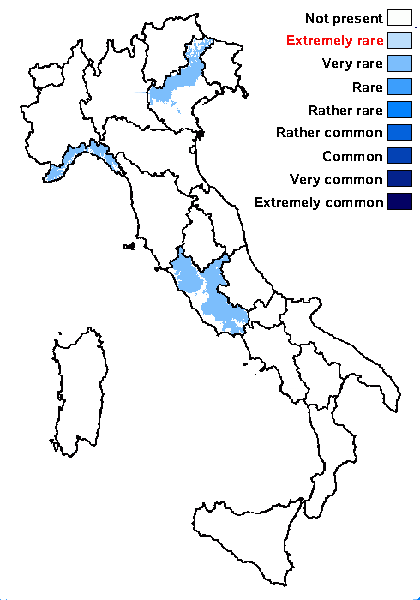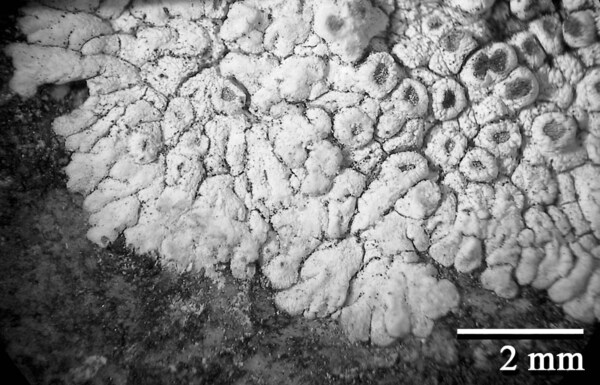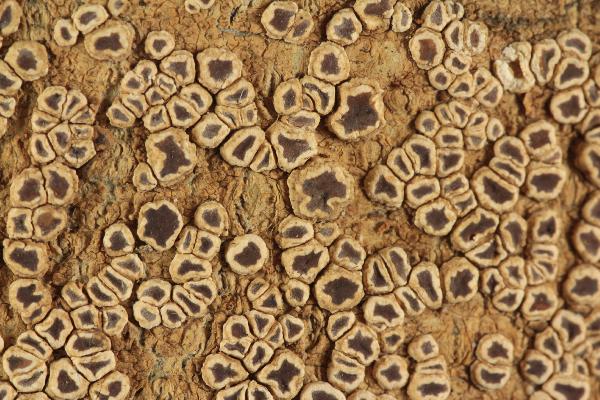Lecanora cateilea (Ach.) A. Massal.
Ric. Auton. Lich. Crost.: 9, 1852. Basionym: Lecanora subfusca var. cateilea Ach. - Lichenogr. Univ.: 394, 1810.
Synonyms:
Distribution: N - Ven, Lig. C - Laz.
Description: Thallus crustose, endosubstratic or thinly episubstratic, continuous to rimose, grey or yellowish grey, epruinose, without a distinct prothallus. Apothecia lecanorine, 0.2-1.2 mm across, with a flat, orange-brown or yellowish brown, strongly to weakly pruinose disc and a thin, finally usually excluded thalline margin. Thalline exciple ecorticate, with many small crystals soluble in K; epithecium grey-brown, with many small crystals soluble in K; hymenium colourless, 60-75 µm high; paraphyses simple to sparingly branched in upper part, 1.5–2 µm thick at mid-level, the apical cells up to 4 µm wide; hypothecium colourless. Asci (8-)12-spored, clavate, very thin-walled, with a K/I+ blue, tall tholus penetrated by a faintly amyloid apical cushion, the wall K/I-, surrounded by a blue outer layer, Lecanora-type. Ascospores 1-celled, hyaline, ellipsoid, 10-13 x 5-7.5 µm. Photobiont chlorococcoid. Spot tests: thallus and apothecial margin K+ yellow, C-, KC-, P+ yellow (apothecial margin only). Chemistry: thallus and apothecial margin with atranorin, chloratranorin and zeorin; apothecial margin with additional psoromic and 2'-0-demethylpsoromic acids.Note: this is a member of the L. albella-group, which includes species with a pruinose disc and an ecorticate apothecial margin. It is distinguished by the polysporous asci and the P+ yellow apothecial margin (psoromic acid), and has a mainly northern distribution in Europe, growing on bark in rather shaded and humid situations. The Italian distribution follows Jatta (1909-1911) who provides a description fitting the essential characters of the species, but the presence of this species in Italy requires re-confirmation.
Growth form: Crustose
Substrata: bark
Photobiont: green algae other than Trentepohlia
Reproductive strategy: mainly sexual
Commonnes-rarity: (info)
Alpine belt: absent
Subalpine belt: absent
Oromediterranean belt: absent
Montane belt: very rare
Submediterranean belt: very rare
Padanian area: absent
Humid submediterranean belt: very rare
Humid mediterranean belt: absent
Dry mediterranean belt: absent

Predictive model
Growth form: Crustose
Substrata: bark
Photobiont: green algae other than Trentepohlia
Reproductive strategy: mainly sexual
Commonnes-rarity: (info)
Alpine belt: absent
Subalpine belt: absent
Oromediterranean belt: absent
Montane belt: very rare
Submediterranean belt: very rare
Padanian area: absent
Humid submediterranean belt: very rare
Humid mediterranean belt: absent
Dry mediterranean belt: absent

Predictive model
 INDEX FUNGORUM
INDEX FUNGORUM
 GBIF
GBIF
 DOLICHENS
DOLICHENS



